 Project 1143.5 STOBAR Aircraft Carrying Cruiser (Tyazholiy Avianesushchiy Kreyser – TAK): Kreml Class. 1982-90:
Project 1143.5 STOBAR Aircraft Carrying Cruiser (Tyazholiy Avianesushchiy Kreyser – TAK): Kreml Class. 1982-90:Admiral Kuznetsov (still active), Riga (Varyag, later PLAN Type 001 Liaoning)
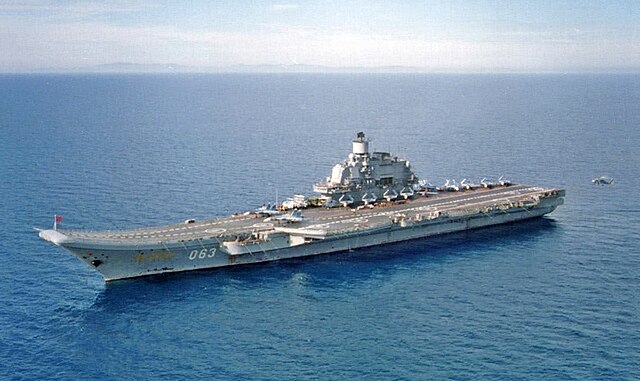
After the Kievs and Kirovs, the USSR had the technical means to build large units, using nuclear propulsion combined with conventional propulsion. Soviet doctrine had led the Admiralty to define only cruisers, possibly able to embark and operate combat aircraft, as in the case of Kiev. But the Yak-38s were poor interceptors and in that role it was not sure that the Yak-41s then under study would be better.
The project of a platform capable of flying conventional take-off navalized interceptors went a long way since 1978. But the new ship role would remain support to Soviet SSBNs, then other secondary roles, not the ones attributed to USN CBGs. Here is the long development and convoluted story of the sole Soviet and Russian aicraft carrier, Admiral Kuznetsov, from her fleeing Ukraine to her service in the Northern fleet, combat in Syria, and overhaul mishaps. Still “active” today, she is planned to remain active until 2050, which for a ship started in 1982 would make her 68 years old…
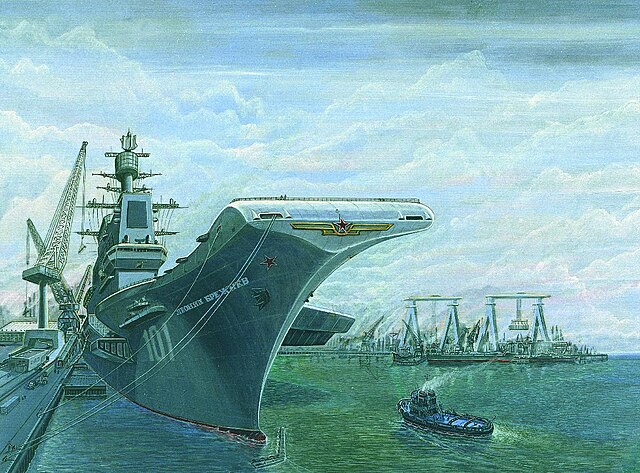
Artistic depiction of the Kuznetsov, when planned back in 1982
Development
Project 1160, 1153, 1143M Orel
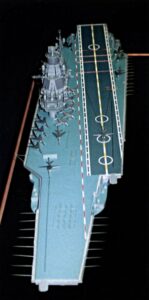 Project 1153 Orel (“Oryol”, “Eagle”) was conceived after Pr. 1143 Krechet, by the late-1970s for an added blue water aviation and set by TTZ at 72,000 tons displacement, equipped with a nuclear power plant with a full capacity of 70 aircraft and using a CATOBAR configuration, with steam catapults.
Project 1153 Orel (“Oryol”, “Eagle”) was conceived after Pr. 1143 Krechet, by the late-1970s for an added blue water aviation and set by TTZ at 72,000 tons displacement, equipped with a nuclear power plant with a full capacity of 70 aircraft and using a CATOBAR configuration, with steam catapults.
Project 1153 code “Eagle” was to be a “large cruiser with aircraft” rated at 70.000 tons and nuclear power plant in 1976 at the Nevsky Design Bureau, based on the unrealized project 1160, under chief designer was V.F. Anikiev. In typical Soviet fashion it came with a proper very large offensive capability mounting 24 vertical launch tubes with anti-ship cruise missiles, SAM and CIWS. Also typically, they were called in Soviet naval nomenclature “large cruiser with aircraft armament”. Project 1153 ad itself derived from Project 1160 Orel, 10,000 tonnes heavier, but cancelled in October 1978 as too expensive. The new Project 1153 smaller was again believed to be too amibitious and expensive, and again, it was declined into a smaller vessel called Project 1143.5, this time V/STOL ship, which TTZ placed it in the 65,000 tons, 52 aircraft range.
After MoD Marshal A. A. Grechko died, the Minister of Shipbuilding B. E. Butoma, also supporter of the creation of aircraft carriers, and under insistence of D. F. Ustinov, the project became TAVKR 1143M (1143.4), the “Admiral Gorshkov” class. It evolved thus as Project 1143.3 Novorossiysk. Project 1153 ships were initially to enter service by 1985. The Air group comprised MiG-23K light fighters and Su-25K attack aircraft with a planned replacement by Su-27KI fighters and Su-27KSh attack aircraft and eventually Project 1143 was realized as the Kuznetsov class, a 55,000 tonnes STOBAR, known as the Ulyanovsk program in the 1980s.
Previous Soviet carrier projects (Conways)
WW2 Designs
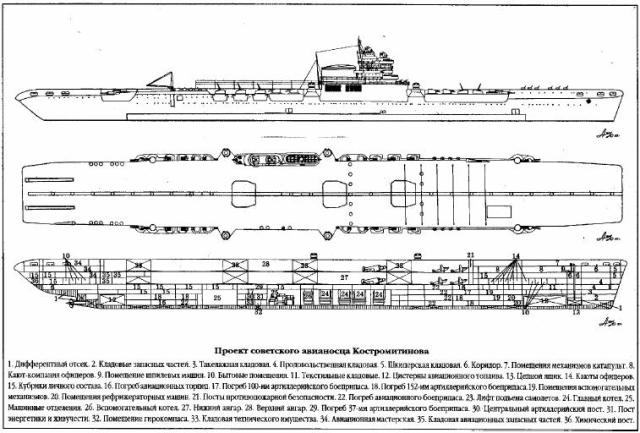
Project Kostromitinov (1939)
The abortive 1938-42 Five Year Plan included two carriers (Project 71), for the Northern and Pacific Fleets, the first to be laid down in 1941, the second in 1942. A 13,000t hull would have accommodated thirty fighters and fifteen bombers. There was also a 10,600t light carrier design, based on the Chapaev class cruiser hull, for twenty aircraft (ten fighters). Both designs were soon considered obsolete. The main naval staff issued new carrier TTZs in January 1943, for carriers to accommodate 30, 35, or 60 aircraft.
TsKB-4 was assigned to develop new plans for a battleship, a carrier and a cruiser. A November 1943 reorganisation shifted carrier work to a new TsKB-17, which was responsible for all later Soviet heavy combatants. The carrier project was redesignated Project 72, and at least some plans were ready by November 1944. At about the same time, the Naval Academy, which had been evacuated from Leningrad to Samarkand, produced a large study of wartime warship development trends.
Late in 1944 the Soviet government decided to redesign existing warships and to develop new ones based on war expenence. A commission to submit proposals was formed in January 1945; it included a carrier branch. The latter proposed fleet carriers for the Northern and Pacific Fleets and small carriers for the Baltic and Black Sea Fleets. The commission suggested that specialists be sent abroad to gain experience on board Allied carriers, that a Liberty ship be converted into a training carrier, and that two American carriers be bought or borrowed for the Pacific and Northern Fleets.
The naval staff doubted that the Allies would agree; work proceeded on home-grown designs. Ultimately the commission proposed light, escort, fleet, and heavy carriers; light and escort carriers would carry air defence fighters, multi-purpose ASW search aircraft, and AA guns; they would differ only in speed and armour. Fleet carriers would add medium multi-purpose aircraft (torpedo bombers) and light multi-purpose aircraft (dive bombers — attack fighters); they would have the same speed as the light carriers, but would be armoured like cruisers, with extra flight deck armour and extra armoured bulkheads near the elevators. Heavy carriers would have more torpedo bombers.
In all, 33 variants were developed, 24 for escorts, 3 for light, 4 for fleet and 2 for heavy carriers. For example, all the escort carriers accommodated 24 fighters and 18 ASW aircraft; an 18,410t ship (armour 25mm flight deck, 50mm deck, 80mm sides and bulkheads, 25mm bulkheads) would have made 20kt on 33,500shp. There was also a much smaller unarmoured equivalent. The light carrier (armoured like the escort) would have displaced 30,560/37,580t (794ft x 97ft lin x 26ft 10in/242m x 29.6m x 8.18m), accommodating 36 fighters and 27 torpedo bombers. Designed armament was 9 twin 100mm, 6 quad 45mm, and 1423mm; she would have made 34kt on 242,000shp. The fleet carrier (35,270/39,670t, 898ft 11in x 105ft 10in/274m x 32m x 10.3m) would have accommodated 24 fighters plus 24 light and 24 medium attack aircraft; designed armament was 12 twin 100mm, 6 quad 45mm, and 2423mm. Armour would have increased slightly; 60mm armoured deck, 100mm side.
She would have made 34kt on 277,000shp. Finally, a heavy carrier (82,370/89,770t, 1148ft 4in x 134ft 6in x 35ft lin/350m x 41m x 10.7m) would have accommodated 16 more medium attack aircraft and would have had a thicker armour deck (150mm). Armament would have been lighter: 9 twin 100mm, 8 quad 45mm, 3223mm. She would have required 384,000shp to make 34kt. Although Stalin apparently initially approved Admiral Kuznetzov’s suggestion that two small carriers should be included in the postwar fleet, he soon concluded that they were not worthwhile, and the 1946-55 programme showed no curries at all.
1950-60s Designs
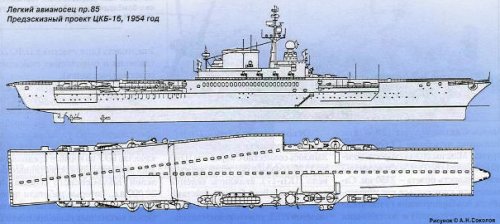
1954 Project 85 carrier
Kuznetsov (supported by Admiral A Golovko) revived the proposal soon after he was reinstated as head of the Soviet Navy in 1951. Stalin never ruled on this issuc. Work on a carrier design did not resume until after Stalin’s death in 1953. A forty aircraft light carrier had been designed by 1955, but it was cancelled in October 1955. Two pre-project designs were developed in 1954, one by TsKB-17 and one by the navy’s internal studies organisation, TsNI-45. Each would carry 40 aircraft (40 fighters) and would have had a range of 5000nm. The TsKB-17 version would have displaced 30,555t, with a speed of 34kts, 16-130mm guns, 100mm side armour, and 70mm deck armour.

Project 71
TsNII-45 suggested 21,000t, with a speed of 32.2kts, 16-76mm guns, and 50mm belt armour. The operational-technical requirements (preliminary TTZ) issued in 1955 called for a displacement of 23,000t to 24,000t, 40 aircraft, 32kts, a range of 5000 to 6000nm, armed with 16100mm guns, with 50mm belt and 70mm deck armour, and 2 steam catapults. In 1989 Admiral Cherniavin claimed that ‘it was decided to move from the simple to the complex from helicopter carriers to full CTOL carriers. Work on the Moskva design began in 1959.
A tactical-technical requirement for a future CTOL carrier (codenamed Orel, “Eagle”) was formulated in the early 1970s; it envisaged a 75,000t to 80,000t nuclear-powered ship to carry at least seventy aircraft, including fighters, attack aircraft, ASW and AEW aircraft. Like a US carrier, she would have had four steam catapults. Admiral Gorshkov decided to include anti-ship missiles as well, A design bureau was assigned to this project in 1973. Marshal Ustinov, the Minister of Defence, asked whether the third Kiev could not be modified with a catapult for MiG-23A fighters, a project called Naverku (‘Upstairs’). It would have carried thirty-six airplanes and helicopters. Ustinov clearly was unwilling to accept the full Orel. A revised staff requirement for a smaller ship (60,000t, fifty aircraft, mainly fighters, with nuclear power) was issued (June 1974).
1970s Designs
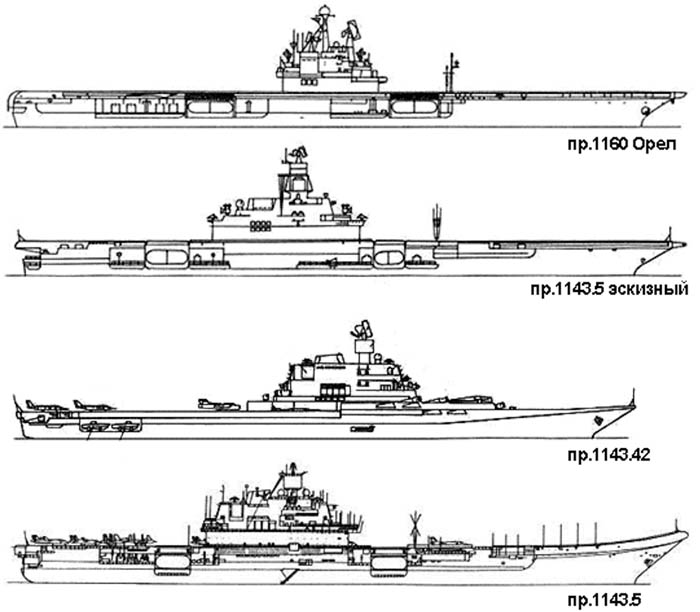
By 1975 the 1978-85 naval programme was being discussed (ie the latter portion of the 1976-80 Five Year Plan and the 1981-85 Plan). Ustinov once more raised the VTOL v CTOL issue. Full-deck carrier plans existed, but none had been approved. The proposal was to include two Orels in the 1978-85 plan. Admiral Cherniavin stated in 1989 that the programme to provide fighters (rather than the Yak-38 attack aircraft flying from the Kiev class) at sea was adopted in 1976, ze for the 197680 Five-Year Plan. In 1979 the design was again revised down, to accommodate forty-two aircraft plus anti-ship missiles. Presumably this was the 7bilis: class. The Ulyanovsk was probably an attempt to return to the full Orel concept.
About 1978, when these carriers were being planned, Admiral N Amelko, formerly commander of the Soviet Pacific Fleet and then Deputy Chief of the Naval Staff, proposed a helicopter carrier as an alternative to the big Tbilisi. He suggested that the ‘Atlantika’ class ro-ro ship, then in series production, be modified as a low-cost helicopter carrier, as an alternative to the projected carriers. A design, code-named Khalzan, was developed in 1980. It was evaluated alongside a possible helicopter carrier based on the Baku and also alongside the new carrier.
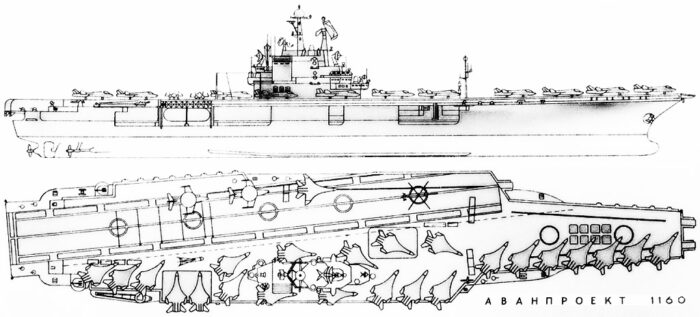
“Avant Project” 1160
Khalzan had a very noisy twin-shaft gas turbine powerplant. It was also argued that she could not have operated the new Yak-141 fighters or the airborne early warming helicopters then in the design stage. Both the alternative designs could have operated both types of aircraft. Khalzan was also considered significantly less survivable against Harpoon and Mk 48 torpedo attack, Kor example, her power plant occupied only a single compartment, one hit on which would have disabled her, She lacked both anti ship missiles of her own and torpedo tubes.
Project 1143.5
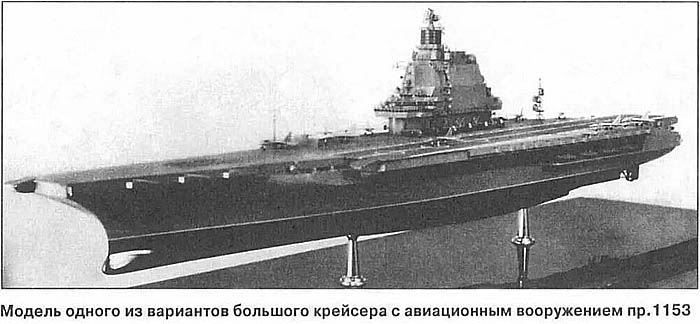
Also called “Kremlin” or “Kreml” was defined since 1979. For NATO, it was “Black com 2” (Black Sea fighter). The Kuznetsov (its final name, abbreviated) is singular in many respects: At 67,000 tons at full load, she remains by far the largest Russian warship ever built, apart from the abortive battleships of 1939. Just 300 meters long, she also had a very large flight deck, 37.8 meters wide. In addition her bridge, although massive, is much smaller than those on the hybrid Kievs (or Moskva) and indeed clears the flight deck like no previous ship in the USSR.
On the other hand she still had no catapult and thus, no CATOBAR capabilities. This had the effect of limiting severely the offensive load of on board fixed wing aicraft. Also to limit them air combat patrols, not heavy ground support. It seems there was an attempt to copy the catapults on the Indian Vikrant (ex-HMS Hercules), unsuccessfully.

However, in the Russian designation, this is still an “aircraft carrier cruiser”. Like any cruiser, she possesses a powerful proper armament, far superior to that of US aircraft carriers: It consists of 24 anti-ship missiles, 8 anti-aircraft missile launchers, and 8 short-range multirole missile batteries, plus 2 ASW rocket launchers and six 30 mm Gatling CIWS for close defence. The onboard group consists of two squadrons, comprising a total of 12 Kamov Ka 32 “Helix” helicopters and 18 “Fulcrum” Mig-29K type aircraft (from 1995), or 24 Su-27 “Flanker” heavy interceptors with 6 helicopters “Helix”.
Paradoxically, the lack of catapults did not prevented the air group to also includes the Sukhoi su-25UT “Frogfoot-B” in a navalized variant for patrol roles, somewhat similar to the Grumman Intruder. Antonov would have, on private ground, studied and proposed also a carrier-borne version of the An-72 “Madcap”, to make a counterpart to the USN “Hawkeye” first warning/AWACS model, but none has ever been accepted in service. Again, without catapult, suc capability of for now out of reach of the Russian Navy, unless using JATO systems.

Rare photo of the two aircraft carriers Vikradaditya (rebuilt Kiev class) and Admiral Kuznetsov in Severomorsk
Roots of the design
The history of the aircraft carrier Admiral Flota Sovetskogo Soyuza Kuznetsov is connected with other ships created under Project 1143. The main tasks of the USSR aircraft carriers differed significantly from the US aircraft carriers:
-Ensuring the safety of SSBNs in their combat patrol areas;
-Air defense of the group escorted;
-Search and Destruction of enemy submarines as part of an anti-submarine group;
-Detection, guidance and destruction of enemy surface forces;
-Covering the landing of naval troops.
However, the narrow specialization of Project 1143 as helicopter carriers did not allow them to effectively cover SSBNs from Lockheed P-3 Orion aircraft with their escort of NATO fighters. The Yak-38 VTOL deployed by the Kievs did not even have their own radar capabilities and were severely limited as interceptors. The ability of the Yak-38 to operate anti-ship missiles also in the air defense zone seemed ineffective. It was necessary to develop the project towards its a true, full-fledged fighter carrier, standard take off and lansing models capable of attacking with long-range missiles and possess their own advanced radar. This led designers to create a carrier for the MiG-29K and Su-33.
Scenarios developed by analysts in the USSR indicated that the most likely, the outcome in a duel with US aircraft carriers would be the rapid incapacitation of deck aviation notably due to nuclear tactical explosions close to the aircraft carriers as shown by Operation Crossroads in Bikini Atooll back in 1946. It proved that the vapor wave from a nuclear explosion washes over the deck of an aircraft carrier. On this basis, Project 1143 was designed to withstand a 30-kiloton nuclear explosion at 2,000 meters from the ship was enough to disable all its systems without sinking the ship itself. This was a crucial step to define in depth the carrier’s new role.
Design and construction
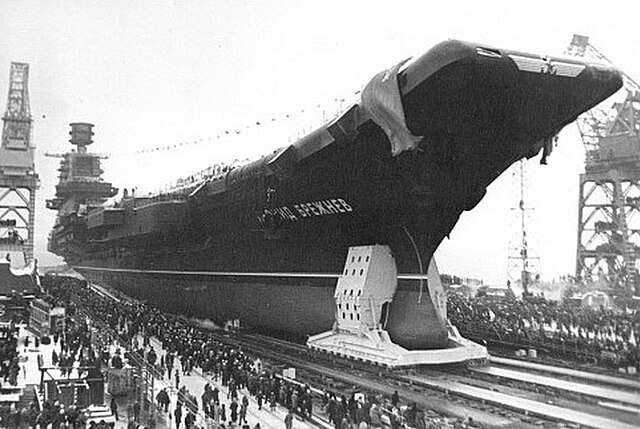
Project 1143.5 was developed in Leningrad at the Nevsky Design Bureau, under the supervision of designers Yu. D. Sergeev and L. V. Belov.
The hull of the 5th “heavy aircraft-carrying cruiser” (TARKR) of the USSR Navy was initially to be “Riga”. One of many names in her complicated history. She was laid down on the slipway of the Black Sea Shipyard, on September 1, 1982. This yard was in Nikolaev, in Ukraine. The ship’s equipment and fittings were manufactured at Leningrad, at the Proletarsky Plant.
The new ship differed from its predecessors in that she was the first to be able to take off and land aircraft of traditional, not VTOL design. These were modified versions of the land-based Su-27, MiG-29 and Su-25. For this purpose, the new carrier had an enlarged flight deck with ski-jump for aircraft takeoff. The construction was carried out for the first time in the USSR by modular approach, with prefabricated large blocks weighing up to 1,400 tons, welded together in final assembly. It was hoped this technique would speeed up delivery of the next carriers, and of course, four were initially planned, one active for each fleet and one in overhaul, alternating.
Even before the end of initial assembly, after the death of Chairman L. I. Brezhnev on November 22, 1982, the cruiser was renamed in his honor. She was launched on December 4, 1985, after which completion continued. Installation of the weaponry was done, except for the block with Granit anti-ship missile launchers, as well as all electrical equipment and wiring, aviation equipment, ventilation and air conditioning, all carried out afloat in completion at the Northern Embankment of the Bolshoy Berthing Quay. On August 11, 1987, Leonid Brezhnev was renamed again “Tbilisi” as new Premier Gorbatchev, a critic of the former regime, wanted her debaptised. On June 8, 1989, mooring trials started. On September 8, 1989, the crew moved in. Soon also the first test pilots Alexander Krutov, Viktor Pugachev and Toktar Aubakirov moved in for initial flight trials.
On October 21, 1989, the incomplete ship was taken out to sea for bot sea trials and allow pilots to conduct a series of flight tests. As part of these, the first takeoffs and landings of the aircraft were carried out. On November 1, 1989, the first landings on Tbilisi were made by MiG-29K, Su-27K and Su-25UTG. The first landings and takeoffs were performed by test pilots Viktor Pugachev on a Su-27K, Toktar Aubakirov on a MiG-29K, and Igor Votintsev on a Su-25UTG. He flew with Research Institute test pilot Alexander Krutov in the rear seat.
The first landing was performed on a Su-27K by Sukhoi Design Bureau test pilot Viktor Pugachev (of “Cobra” manoeuver fame). On the same day, the first takeoffs were performed by MiG-29K with Mikoyan Design Bureau test pilot Toktar Aubakirov, and Su-25UTG from Sukhoi Design Bureau test pilot Igor Votintsev. The next day on November 2, 1989, by an Su-27K. After completing this test cycle on November 23, 1989, the carrier returned to the yard for fixes and final completion. In 1989-1990, she returned at sea for more factory and state tests.
On October 4, 1990, she was renamed for the third time “Admiral of the Fleet of the Soviet Union Kuznetsov”. This became permament, even after the USSR collapsed.
After this, the economy also collapsed, making the future of the program more than uncertain. The second carrier, bapstised Riga after the first one was debaptized, was renamed again Varyag. She was laid down at the same yard as her sister and same launching pad, but on 6 December 1985 (see below).
Design of the class
Hull and general design
The basic hull design was derived from the 1982 Kiev class, but larger in both length and beam and instead of an angled flight deck, with a cruiser on the foredeck, the Kuznetsov had a full-length flight deck with side island. Her impressive twelve anti-ship cruise missiles were located in launchers below the flight deck aft of the ski-jump in VLS. So that aircraft could roll over if needed. This however restricted hangar space.
This new aircraft carrier used a STOBAR configuration: Short Take-Off But Arrested Recovery. Short take-off because of her 12-degree ski-jump on bow. And angled recovery deck with arresting wires to land without interfering with launches. A system developed both in the UK and the US and which was widespread. The flight deck has a total area of 14,700 square metres (158,000 sq ft) with two aircraft elevators starboard forward and aft of the island. In addition there were smaller armaments elevators to complete equipment on deck, but this was rarely used. All aircraft were equipped in the hangar.
The hull again apart the ramp recalled the one from the Kievs, which was not that smaller, but the flare on both sides of the hull was considerable to meet the largest deck width possible. The bow ended in an overhanging blended straight deck lip, but the prow itself is flattened and sloped. The acnhorts are not vivible, hidden inside side flanges. The transom stern is broad and three-faceded, with a rounded lower section. There is also a gallery at the poop and the deck well above. Sponons are massive, especially below the angled deck. On the other side they are about half in extension, but deeper, as the amidship section needs to support the massive island. The latter is staggered to support all radars for the onboard weapons systems and fire controls as well as a large air search radar. There are a bridge forward mid-way up the island and another aft to monitor air operations, linked by passegeways.
Powerplant
Unlike most in the west would believe, given Soviet experience with nuclear power, Admiral Kuznetsov would have a conventional powerplant. She was equipped after debates and deliberations with four GTZA-674 geared steam turbines, fed by eight KVG-4 boilers. Each turbines developed 80,000 shp (60,000 kW) for a grand total of 200,000 shp (150,000 kW). Top speed as contracted was 29 knots (54 km/h; 33 mph). The boilers steam pressure is of 66 kg/cm² with a capacity of 115 tons of steam per hour (increased compared to the predecessor Kiev class at 98 t/h). There are no auxiliary boilers. The propellers are five-blade bronze screws with a fixed pitch, 426 cm diameter.
Maneuverability is assessed as good with a turning circle at 14.5 knots of 2.1 ship lengths.
The Range is 8,500 nmi (15,700 km; 9,800 mi) at 18 knots (33 km/h; 21 mph) or 3,800 nmi (7,000 km; 4,400 mi) at 29 knots (54 km/h; 33 mph) top speed.
When anchored she could count on two 15-ton anchors on the bow. Her crew could evacuate the ship via 5 boats (commander’s cutter project 1404, two working cutters project 1402B, two oared boats P6à and 240 inflatable rafts supended on side sponsons.
There were advantages and disadvantages of a fuel oil power plant, as commented by former commander of the Northern Fleet Admiral Vyacheslav Popov when interviewed about the powerplant repairs. It was found smoking a bit too much and this was also commented in the western press. The admiral replied that “only amateurs do not know that a propulsion system running on such cheap fuel as fuel oil is always distinguished by increased smoke formation”. According to the admiral, current repairs were carried out efficiently. It was also said that smoke was also typical of USS Freedom series. An officer of the US 3rd Fleet command commented this was normal after a ship was stationary for a long time, there was a lot of carbon deposits expected, igniting and burn out when the macinery is lit up again. It was eventually to be entirely burnt out.
It was pointed out the advantage of a fuel oil was to be a very cheap fuel, with low cost routine maintenance. In fact the cost of a nuclear power plant led to abandon the next class fue to the exorbitant cost of maintenance. It was also argues that the oil storage was designed in such a way to absorb torpedo blasts, as part of the ASW protection system. It was described as a “three-chamber anti-torpedo protection system”, in layered compartlents and double hull. The fuel is inert, slows down the blast radiance and catch all fragments generated by the explosion.
It was calculated able to resist 400 kg TNT. However the state of late Soviet nuclear designs and new Russian designs from the 2000s led to believe that a new modernization should include two compact KN-3 forced-type nuclear reactors (in the space of four boilers) and brings the unlimited range needed for oceanic operations, while the remaining four boiler providing emergency cruising speed of 12 knots. But this was not implemented for financial reasons in her last major mid-life overhaul.
Protection
About ASW protection with oil, as seen above, it is completemnted by three longitudinal bulkheads, with the 2nd bulkhead armoured, thickness unknown, probably in the order of ine inch or 25mm.
there are very likely armour protection around the CC, box protection above and around ammunition storage rooms deep inside the ship, as well as kerosene tanks, and the steering system aft. Details are unknown. The machinery spaces are all separated for redeundancy with wide separations between the turbines and boilers rooms, with transverse and longitudinal bulkheads. Again, thickness is unknown.
As for active protection, aside arament (se below), this consists in the following systems:
TK-146 Sozvezdiye-BR:
MP-407 Start-2 ECM suites:
8x PK-2M:
4x PK-10 Smely decoy RLs:
Lesorub-4342 CCS:
Armament
Anti-ship Systems

Probably unique among carriers in service worlwide, the Kuznetsov was completed with a full battery of anti-ship missiles, according to her name of “heavy cruiser”. Her combat suite is a bit less developed than a Kiev or a Kirov of course, but still she punches at a level of a guided missile cruiser.
Admiral Kuznetsov carried indeed no less than twelve 4K80 launchers for heavy Granit missiles. They are cruise missiles, capable of hitting targets at 600 kilometers with a 750 kilograms warhead, conventional or tactical nuclear.
The Granit launchers were mounted (before their removal) under the flight deck ski-jump. The silos were closed by a flat cover flush with the deck so that any fully loaded 30+ tons aircraft could roll over. Painting identified the silos. When launched, flights were of course stopped, with an announcement from the bridge. The initial idea was to add some punch or a second strike if the escort was destroyed, in order to counter-attack and destroy US carrier group. The missile when initially designed was conceived as a “carrier killer”. Not sinking, but at least powerful enough to seriously disable a carrier and start fires.
Specs 12 P-700 Granit (SS-N-19 Shipwreck):
Mass: 7,000 kg (15,400 lb), dimensions 10 m (33 ft) x 0.85 m (33 in)
Warhead: HE 750 kg (1,653 lb) or nuclear (500 kt)
Engine: Turbojet and ramjet, range 625 km (388 mi)
Speed Mach 1.6 (low altitude), Mach 2.5+ (high altitude).
Inertial guidance, active radar homing with home-on-jam, Legenda satellite targeting system.
Advantages and disadvantages of heavy missiles “Granit”:
The presence of this heavy weapon system shared by the Oscar class SSGNs and Kirov class battlecruisers was thought enough for breaking through missile defense and air defenses of US CBGs back in the late 1970s. It was was intended to create an advantage in a duel between carrier groups. It was believed the entire missile salvo was aguarantee for at least a hit on the enemy carrier. It required precise target designation by the aviation complex “Uspekh”, which at the time was provided by a Tu-95RC aircraft, or the onboard Ka-25 helicopters to fire over the horizon, or other systems to precise target coordinates. I was since update with Lotos-S satellite course correction and GPS.
The main technical limitations were that the missiles would be used without control in flight, simply entering the target coordinates obtained at launch and not necessarily via Lotos-S satellite. The missile follows the specified coordinates using inertial navigation system, independently finding targets at the final stage with active radar. However from a long distance and if the target was moving quickly and maneuvering, the homing head may not be enough to lock on, especially through intense electronic warfare environment. Therefore, additional target designation by radio was added, but this could be jammed as well. The system was considered obsolete and retired in the 2020s refit, the space gained for extra hangar area.
AA/Anti-Missile Systems
Admiral Kuznetsov has its own short-range anti-missile weapons to face incoming missile and bomber attacks.
Her primary CIWS consist of four six-barrel Kinzhal SAM launchers (192 missiles), and eight Kortik launchers (256 missiles; being replaced by Pantsir-M as well as six 6-barrel “classic” 30-mm rapid-fire AK-630M CIWS (48,000 rounds). They all covered various ranges, in the order described above (see below for details).
3K95 Kinzhal (SA-N-9 Gauntlet) SAMs:
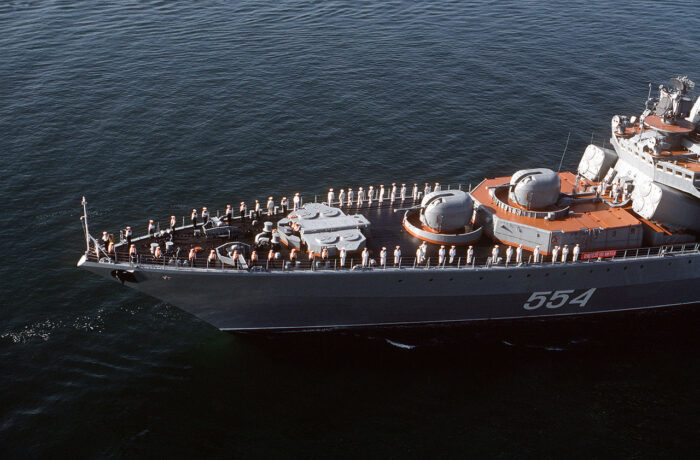 Naval version of the Tor missile system from Altair with the same 9M330 missile also shared by frigates, destroyers, the Kirov-class multimission cruisers. It entered service in 1989, stored within rotary VLS modules. Six modules for 192 total on Kuznetsov and Kirov), mounted flush to the deck. Each module has up to eight missiles stored ready to fire. It is guided by the 3R95 fire control radar (NATO Cross Swords) with an acquisition radar (maximum detection range 45 km/28 mi).
Naval version of the Tor missile system from Altair with the same 9M330 missile also shared by frigates, destroyers, the Kirov-class multimission cruisers. It entered service in 1989, stored within rotary VLS modules. Six modules for 192 total on Kuznetsov and Kirov), mounted flush to the deck. Each module has up to eight missiles stored ready to fire. It is guided by the 3R95 fire control radar (NATO Cross Swords) with an acquisition radar (maximum detection range 45 km/28 mi).
Specs:
Mass 167 kilograms (368 lb), 2,9 m (110 in) x 23,5 cm (9.3 in), wp 65 cm (26 in).
Warhead Frag-HE: Fragmentation high explosive, 15 kg (33 lb), RF Proximity fuse
Propellant: Solid-fuel rocket, 850 metres per second (Mach 2.5).
Range 12 kilometres (7.5 mi; 6.5 nmi), ceiling 6,000 metres (20,000 ft)
Guided by Radio command, using gas dynamic control system with four control surfaces
Kortik launchers
 The CIWS 3K87 Kortik is exported as Kashtan (NATO CADS-N-1 Kashtan). The Kortik is deployed the Kuznetsov, Kirov-class, Neustrachimy-class frigates, and Chinese Sovremenny-class. Combined gun and missile system to face anti-ship missiles, anti-radar missiles, and guided bombs. Currently replaced by the Pantsir-M CIWS with same rotary guns but new missile and radar systems. 15,500 kg (34,200 lb), fires the HEI-Frag, Frag-T, APDS-T 0.39 kg (0.86 lb) (HEIF, FT) and 0.30 kg (0.66 lb) APDS-T (Caliber 30×165mm AO-18). Effective range 1,500–10,000 m (4,900–32,800 ft).
The CIWS 3K87 Kortik is exported as Kashtan (NATO CADS-N-1 Kashtan). The Kortik is deployed the Kuznetsov, Kirov-class, Neustrachimy-class frigates, and Chinese Sovremenny-class. Combined gun and missile system to face anti-ship missiles, anti-radar missiles, and guided bombs. Currently replaced by the Pantsir-M CIWS with same rotary guns but new missile and radar systems. 15,500 kg (34,200 lb), fires the HEI-Frag, Frag-T, APDS-T 0.39 kg (0.86 lb) (HEIF, FT) and 0.30 kg (0.66 lb) APDS-T (Caliber 30×165mm AO-18). Effective range 1,500–10,000 m (4,900–32,800 ft).
AK-630M CIWS
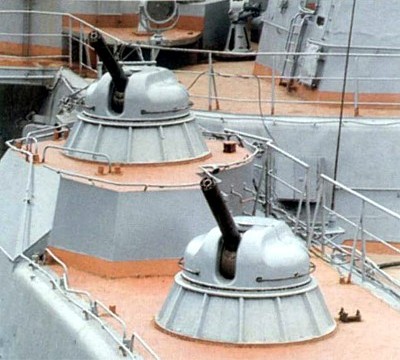 Classic system, last evolution in 2007 with the M2. 1,800 kg (4,000 lb) (AK-630M), barrel 1,629 mm (64 in), 1,240 mm (49 in) mount ring and 1,070 mm (42 in) in height above deck, 2050 mm below. Fires HEI-Frag, Frag-T 0.39 kg (0.86 lb) 30×165mm AO-18 with 6 barrels, 4,000–5,000 rounds/min, effective range 4,000 m against aicraft, 5,000m surface. 9,000 rounds/min guns and 1–2 (salvo) missiles per 3–4 sec.
Classic system, last evolution in 2007 with the M2. 1,800 kg (4,000 lb) (AK-630M), barrel 1,629 mm (64 in), 1,240 mm (49 in) mount ring and 1,070 mm (42 in) in height above deck, 2050 mm below. Fires HEI-Frag, Frag-T 0.39 kg (0.86 lb) 30×165mm AO-18 with 6 barrels, 4,000–5,000 rounds/min, effective range 4,000 m against aicraft, 5,000m surface. 9,000 rounds/min guns and 1–2 (salvo) missiles per 3–4 sec.
AA/Anti-Missile Systems
The ASW suite might sound susprising for an aicraft carrier, but it is well developed, with an multi-layered defense.
At the top are of course the Kamov Ka-27PL helicopters (see below).
Next are two RBU-12000 launchers (60 missiles), which can be setup for false acoustic targets, anti-torpedo minefields.
The ship also carries torpedo decoys and her own depth charges.
About the Granit missile system replacement
In 2001, NPO Mashinostroyenia starrted work on upgrading the Granit missile system and align it on the Yakhont export version, borrowing its navigation systems and radar. On October 16, 2016 an upgrade of the Granits was tested on coastal targets. Experts such as Konstantin Sivkov, believed the updated system was now only useful in hitting area targets provided there is ni local missile defense system due to their impressive payloads.
In April 2016, sveral sources reported on plans to replace the Granit with universal launchers, likely the more compact ZS-14 Kalibr and Oniks families or the Zircon (hypersonic). Satellite images during overhaul showed the removed Granit, ZS-14s being installed.
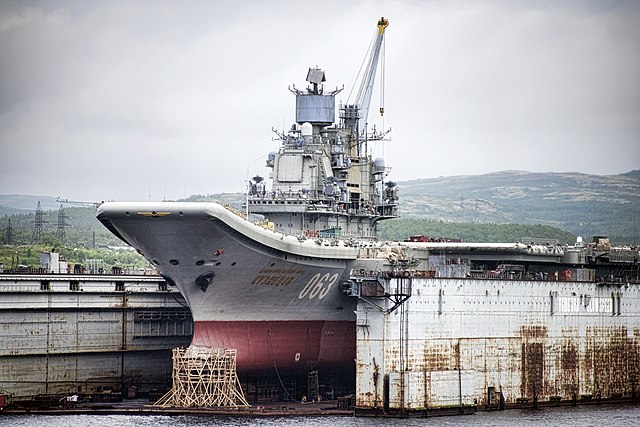
Sensors
Admiral Kuznetsov is equipped with D/E band air and surface target acquisition radar. It is a passive electronically scanned array.
It is completed by an F band surface search radar and a G/H band flight control radar as well as an I band navigation radar and four K band fire-control radars for the Kashtan CIWS. The ship also had an hull-mounted medium to low-frequency search and attack sonar.
The ASW helicopters (see below) are themselves equipped with a search radar and dipping sonar as well as sonobuoys and magnetic anomaly detectors.
The complete list is below (to be updated in future updates).
Mars-Passat radar suite:
MR-750 Fregat-MA:
2x MR-350 Podkat:
2x MR-212/201 Vaygach-U:
Nayada-M:
4x 3R-95:
3x MR-123 Vympel-A:
Rezistor-K42:
2x Gazon radars:
MGK-355TA Polinom-T:
MGK-365 Zvezda-M1:
MG-717 Amulet-1:
Altyn:
Varyag was to have a completely different setup (updates to come):
Forum radar suite:
MR-650 Podberiozovik:
2x MR-750 Fregat-MAT:
2x MR-350 Podkat:
2x MR-212/201 Vaygach-U:
Nayada-M:
4x 3R-95:
3x MR-123 Vympel-A:
Rezistor-K42:
2x Gazon radars:
MGK-355TA Polinom-T:
MGK-365 Zvezda-M1:
MG-717 Amulet-1:
Altyn:
TK-146 Sozvezdiye-BR:
MP-407 Start-2 ECM suites:
8x PK-2M:
4x PK-10 Smely decoy RLs:
Lesorub-4342 CCS:
Air Facilities

In the original project specifications, the air group was 33 fixed-wing aircraft plus 12 helicopters. Sukhoi Su-33 fighters (navalized Sukhoi Su-27 Flanker) were its prilary fight-bomber, to wich later the Mig-29K was added. And the Kamov Ka-27 naval utility helicopter for ASWn SAR, patrol and naval assault. For the latter, there was also the Kamov Ka-52K “Katran” attack helicopter (variant of the Kamov Ka-50).
The facilites copmrised at first a flight deck which measured 306.5 meters long (1,001 ft) by 72 meters wide (236 ft 3 in), larger than any European carrier. In surface it represented 14,800 m² (159,300 ft sq.). The hangar was however small due to compromises made with the installation of heavy armament, notably the Kinzhal missiles. It was mostly a rectangle, measuring 153 meters (501 ft) long for 26 meters (85 ft) in width and 7.2 meters (23 ft) in height. It was barely half the entire ship’s lenght, and about the hull’s beam. There was barely enough space for the SU-33 tail, not enough to suspend anything than compact gantry cranes to lift and move around heavy loads, such as reactors and armaments. The hangar surface was 3,978 m² (42,800 ft sq) or 28,642 m³ (1,011,482 ft cu) in volume. There were also two deck-edge elevators (capacity 40t, 20 x 15m or 66 x 49 ft). Aircraft fuel stowage was quite small compared to US carriers with just 2,500 t of jet fuel.
Being the first full-fledged aircraft carrier in Soviet service, with horizontal takeoff and landing aircraft, Admiral Kuznetsov still carried older shortcomings from the Kiev type. The focus on replacing full-fledged steam catapults with a ski-jump led to lightened takeoff and landing operations, notably due to the presence of only one direction for takeoff and the aforementioned decrease in combat load and fuel (thus radius). The big issue was the problem of thrust-to-weight ratio at takeoff. On the other hand a ski-jump allowed significant savings on weight in internal volume as well as energy required and reduced maintenance greatly. It also increased stability and in case of breakown, ensured the continuation of operations. The absence of catapult however required the navalized Su-33 to be equipped with more powerful engines and afterburners, the AL-31F. Cost increased, but this gives them an advantage in air combat as stated by famous test pilot Pugatchev which argued this by far the “world’s most powerful and agile” with a ratio mass/propulsion superior to 1.2.
Air Group

MiG-29KUB (Project 9.47): Identical characteristic to the MiG-29K but with tandem twin seat configuration. Advanced trainer for MiG-29K pilots but full combat capable. Originally designed for the Indian Navy (maiden flight 22 January 2007). NATO “Fulcrum-D”.
The lack of catapults, added to only two lifts had quite an impact on the availability of AWACS since they could not take off from a ski-jump. The ship thus is limited to her own relatively short radar detection range. Capacities for over-the-horizon detection was limited to AWACS helicopters, slow and short range but a solution was later found with a variant of the Su-33 as reconnaissance model, but this was not adopted. In 2015, the “universal reconnaissance container” was adopted for reconnaissance, divided into three containers carried by a Sukhoi to perform reconnaissance (electronic reconnaissance, long-range two-way AFAR radar, electro-optical reconnaissance pods).
To coordinate actions they still needs communication with the aircraft carrier, whereas AWACS could project this command and control capability without giving away the aircraft carrier by intensive radio communications.
The MiG corporation confirmed that the MiG-29K is also capable of providing on its own optical-electronic reconnaissance with its own pod and a target designation system. The latest version of the Mig is also enhanced by the Zhuk-M radar with a range of 300 kilometers and can detect and designate targets for long-range missiles such as the RVV-AE (110 kilometers) and Kh-35 (260 kilometers).
Helicopters for ASW and Assault Operations
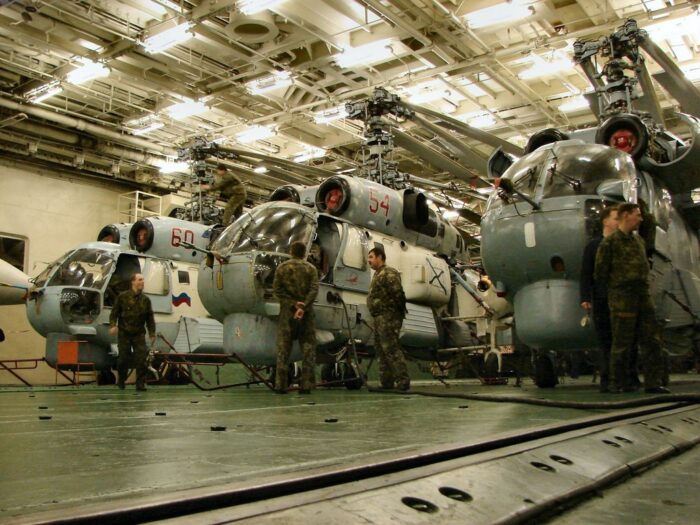
A group of Kamov Ka-27 stacked in the hangar. A much as six could be stowed in a row. In a purely amphibious role, the carrier thus could carry about 60 helicopters or much more with those already parked on deck.
Most of the ships of Project 1143 (Kievs) did not have a full-fledged flight deck for aircraft, but carried a very large number of Ka-27PL anti-submarine helicopters. In fact Project 1143 ships were primarily designed as heavy ASW helicopter carriers, covering the deployment area of ASW submarines for a strike on US territory, from possible attacks by the US Navy’s Los Angeles-class SSNs.
The Ka-27 helicopter is versatile and could carry out landing operations, dropping 16 marines, providing them with fire support with S-5 or S-8 unguided missiles as well. The Project 1143 thus could provide a goos support for landing operations. Later, the Ka-29 was created on the basis of the Ka-27, with an assault specialization and Ataka ATGMs to deal specifically with armored vehicles. A further development led to the Ka-52K strike helicopter with the Hermes ATGM being adopted.
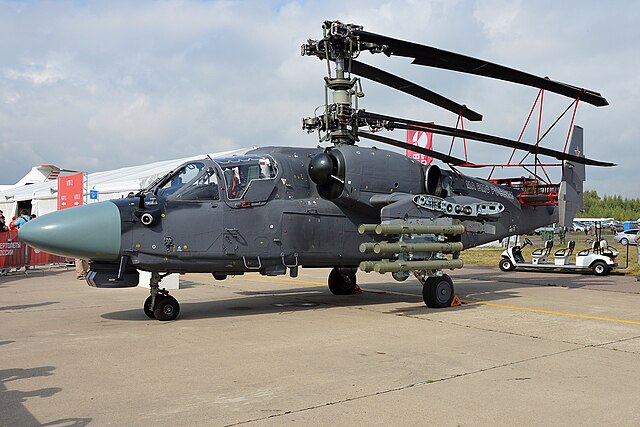
The Ka-52K, was at first oplanned for ampihbian operations on the later cancelled BPC Mistral built in France and sold to Egypt with the same Russian park. It was introduced as an armament option with its powerful Zhuk-A radar with target detection range of up to 200-300 kilometers and long-range missiles to destroy armored vehicles. The Hermes ATGM (30 kilometers). This attack helicopter thus avoids entering the range of all MANPADS, but also many short-range air defense systems.

Tbilissi, the first name of this aircraft carrier – Author’s illustration.
⚙ specifications |
|
| Displacement | 43,000t light, 55,000t standard, 58,600t FL |
| Dimensions | 305 x 72 x 11m (1,000 ft 8 in x 236 ft 3 in x 36 ft 1 in) |
| Propulsion | Steam turbines 80,000 shp (60,000 kW)n 200,000 shp (150,000 kW) |
| Speed | 29 knots (54 km/h; 33 mph) |
| Range | 8,500 nmi (15,700 km; 9,800 mi)/18 kts, 3,800 nmi/29 kts |
| Armament | 12 P-700 Granit SSM, 192 3K95 Kinzhal SAM, 8x Kashtan CIWS, 6 AK-630, UDAV-1 ASWRL |
| Protection | 1 SPV, 8x EW Side Globes, 12x EW Bell, 4x Rum Tub 2×2 Decoy RL |
| Sensors | Radar 2 Palm Front, Top Sail, Top Steer, 2 Head Light, 2 Pop Group, 2 Owl Screech, 2 Bass Tilt, 1 Trap Door. 1 Sonar of bow |
| Air Group | 18–32× fixed-wing aircraft, 18–24 × helicopters |
| Crew | 1,500 |
 Kuznetsov (1985)
Kuznetsov (1985)
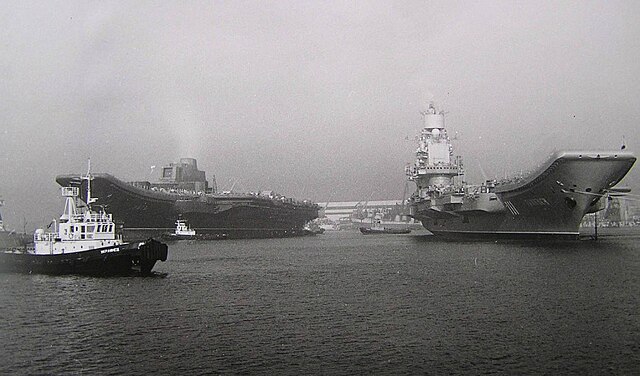
She was renamed under construction, which began in 1983 in Nikolayev, under the name of “Riga”, then renamed “Brezhnev” after the latter was deceased, and launched as such in December 1985, and following the previous regime denunciation by Gorbachev, at the time of her completion she was renamed again “Tbilisi”. This was under this new name that after January 21, 1991 she started a series of tests. Georgia then knew serious political disturbances, accompanied by violence, and after the communist fall, the carrier was named for the last time “Grand Admiral of the Russian fleet Kuznetsov”, reduced since to “Kuznetsov”.
The name is a tribute to the grand admiral of the Soviet Navy for 30 years striving to give the Soviet navy its status as a true blue water, ocean spanning fleet, and she remains the only carrier of the Russian Navy today, as the Kiev class werd discarded. Anchored in the Black Sea, she made various cruises in the Mediterranean, and in 1996, was taken over for a two-year revamp. She took part in Kursk’s backup operations and returned to port for maintenance operations. In the late 1990s she started to deploy Sukhoi Su33 “Flanker”.
But without catapult, their limited capabilities led the office to define a specific naval interceptor, but these costly studies were quickly abandoned. Now the main role of the carrier is just to maintain skills and training of pilots on board until a better CATOBAR carrier is built (so far it’s unlikely to be announced with the war in Ukraine draining all Russian resources, see later). Everything has been done to ensure that Kusnetsov maintains operating budgets. In 2004 he took part in a “friendly cruise” with her group (cruisers Petr Veliky (Cl. Kirov), Marshal Ustinov (Slava class), destroyer Admiral Ushakov, two tankers and two floating workshops. A new cruise started in the fall of 2005 (see later) followed by a major modernization in 2017, since she was launched back in 1985 (32 years old).
Transfer to the Northern Fleet
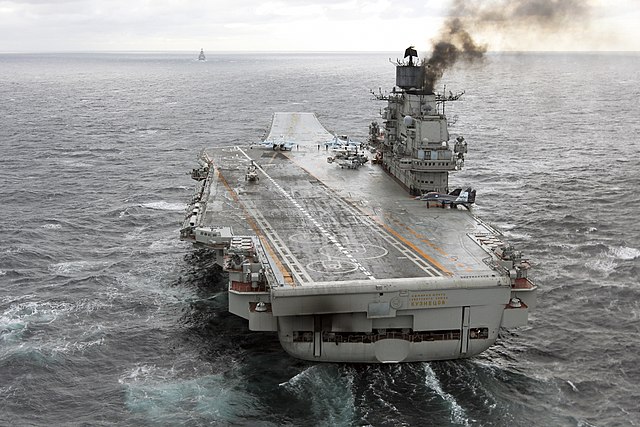
The transfer to the Northern Fleet, since Ukraine became independent started with discussions from December 1991, as the carrier commander received a government telegram from then Ukrainian President Leonid Kravchuk, explaining that she was now the property of Ukraine until a Russian government decision was made, and should remain in Sevastopo. The captain decided he would have none of it and sailed for Feodosia training ground to practice takeoffs and landings as he was authorized, and meanwhile, the Deputy Commander of the Northern Fleet Vice-Admiral Yuri Ustimenko, urgently flew from the Northern Fleet to Crimea to settle matters.
Upon arriving on board her gave the order to prepare for a crossing without two-thirds of the officer and warrant officers, still on shore as well as the factory acceptance team, in order to escape a possible seizure by Ukraine. The transfer to the Northern Fleet before completion of state tests was a unique case in the annals of the Russian Navy, and the greatest issue was the crossing of the Dardanelles. At that stage the ship was to depart withour technical documentation, neither engineers and test pilots were present in numbers nor have any training. This situation went on until mid-autumn 1994 due to regorganization when she was later in the northern fleet.
At 23:40 on November 30, 1991, without giving any warning to Sevastopol authorities, Captain 1st Rank V.S. Yarygin left the roadstead and headed for the Bosphorus. Kuznetsov entered the strait at 30 knots, and at a narrowing point at 20 knots. She passed through the strait on December 1, 1991 and the Turkish authorities did not impede the vessel’s movement. In theory the 1920 Montreux convention forbade any passage of such ships throuh the Dardanelles. Indeed the Russian government via its embassy made known to Istambul that at that stage, she was non operational, still not in service and incomplete. Plus she flew the flag of USSR that no longer existed, instead of the new Russian Federation. Still Turkey never granted officially the permission to pass but did not blocked her. Thus alone put the convetion seriously in doubt.

On December 20, she was registered in the Northern Fleet, and the naval flag of USSR still flying was replaced by the Russian Navy flag. On December 24, 1991, Admiral Kuznetsov arrived at her permanent base in Vidyayevo, Murmansk Oblast.
The start of a new career
On January 20, 1991, she was officially delivered and assigned to the Northern Fleet, so commissioned. In November 1991, commander Viktor Yarygin received a telegram from the Verkhovna Rada of Ukraine, Leonid Kravchuk that she still was the property of Ukraine and should remain in Sevastopol until a bi-national decision was made. However, from Commander Yarygin’s point of view, the state Ukraine did not yet existed when he departed. The referendum for the independence of Ukraine had not yet been held still. He thus obeyed to the instructions of the command of the Northern Fleet, under direct orders from Rear Admiral Yuri Ustimenko in person aboard. Part of the crew and flight personnel remaining on shore had to either leave Ukraine and acquire the enw Russian Citizenship or leave the service if remaining an Ukrainian national.
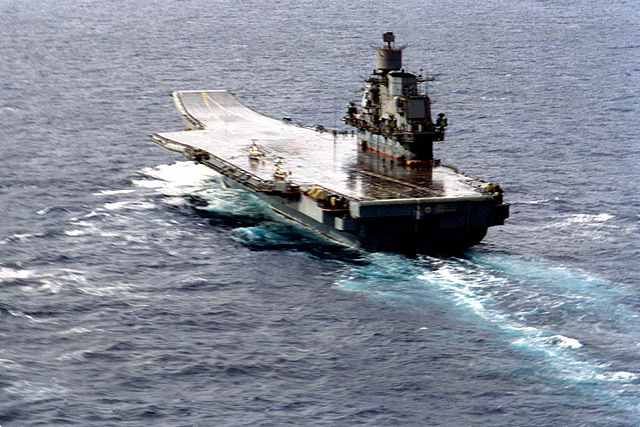
From there, the situation somewhat became tragi-comical: The 100th Naval Aviation Regiment commanded by Timur Apakidze (remaining on shore) refused to take the oath of allegiance to Ukraine and formed the core of the 279th Naval Aviation Regiment of Russia. The flight crew who took the oath of allegiance to Ukraine were dismissed due to the disbandment of the 100th Regiment. Ukraine inded having no aircraft carriers.
Entry into service (1994-2008)
From 1992 to 1994, tests went one, weaponry, air group and she spent 3-4 months yearly at sea for exercises. In 1993, the first serial Su-33s joined the first air group. On December 23, 1995, she took part in the first Russian Carrier Battle Group (12 ships including the destroyer Besstrashny, patrol ship Pylkiy, and support vessels) headed by Deputy CiC Admiral I. V. Kasatonov. She started her first combat mission in the Mediterranean with 13 Su-33s, two Su-25UTGs, and 11 helicopters on board, a rather modest complement. The mission lasted until February 4, 1996 and she travelled 6,245 miles, performed 220 aircraft flights as well as live firing with port calls at Tartus (Syria) and La Valletta.
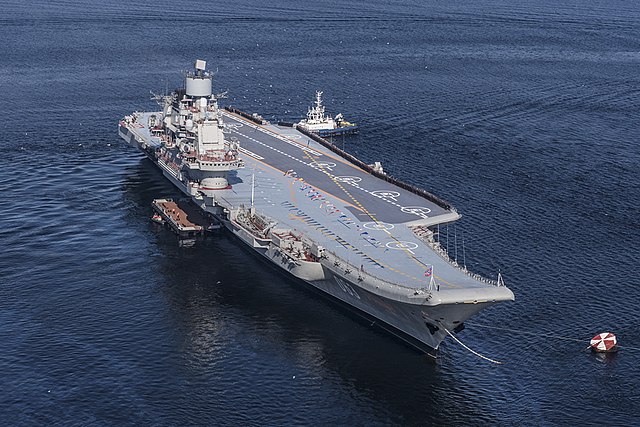
From 1996 to 1998, she had an overhaul, greatly delayed due to a lack of funding. In 1998, she took part in major exercises with the Northern Fleet and in 1999 made two combat training sorties. In 2000, she took part in major exercises and took part in the localization and salvage operation of K-141 Kursk. As a result of this tragedy her second sortie in the Mediterranean Sea was to start at the end of 2000, but was cancelled.
From 2001 to 2004, she was in drydock for scheduled maintenance. In 2004 she took part in a CBG with 9 Northern Fleet ships including Pyotr Velikiy, Marshal Ustinov, Admiral Ushakov and support vessels and stayed a month in the North Atlantic, flying the new Su-27KUB. In 2005-2007 she made on average 2-3 sorties yearly.
On December 5, 2007, Kuznetsov led a detachment for a double deployment in the Atlantic Ocean and Mediterranean until February 3, 2008.
On December 8, 2008, she was in overhaul for seven months at Zvezdochka until completed. Her main power plant was updated, her boiler overhauled and air conditioning system as well, also the lifts mechanisms and cabling an all weapons systems and sensors were recalibrated or modernized.
Mediterranean Operations (2011-2015)
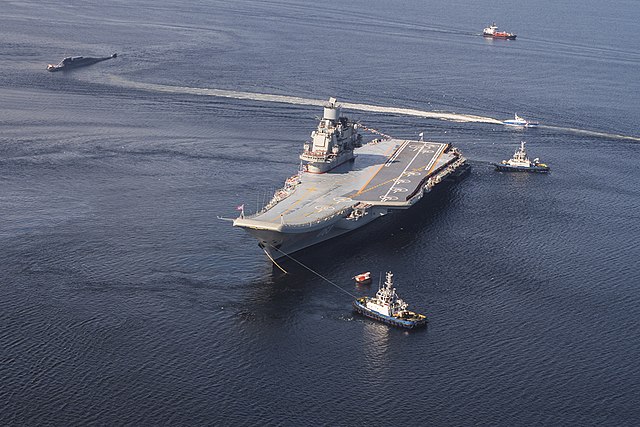
On December 6, 2011, Admiral Kuznetsov sortied with her CBG of the Northern Fleet to the Mediterranean and headed for Tartus and the shores of Syria. She completed this 7th long-distance deployment in May 2014.
On March 13, 2015, MiG reported that in 2014 it delivered 14 new MiG-29K fighter-bombers and four more MiG-29KUB with new avionics and the new Zhuk-M AFAR radar to Kuznetsov’s air group. By the end of 2015 these completed state contract delivery with another ten to follow.
From May 14 to August 20, 2015, she was under maintenance at the 82nd Ship Repair Plant in Roslyakovo. From January to June 15, 2016 she entered tje 35th Ship Repair Plant in Murmansk, trying to reach full technical readiness before a long-distance deployment. At that stage it’s good to recall her hull and powerplant were already 30 years old (she was launched in 1985). So in theory she was already approaching retirement age. However by comparison with the USN this is very unlikely as the latter maintains its supercarriers for 40+ years at least.
In late 2015 she hosted a science fiction film on board, released on January 26, 2017.
In January 2016, she had the 100th “Crimean” naval aviation regiment re-formed o,board with the new 24 MiG-29K/KUB. The 279th naval aviation regiment remained operational aboard with its park of Su-33 aircraft but modernized with engines and bomb sights.
Combat in Syria (2016-2017)
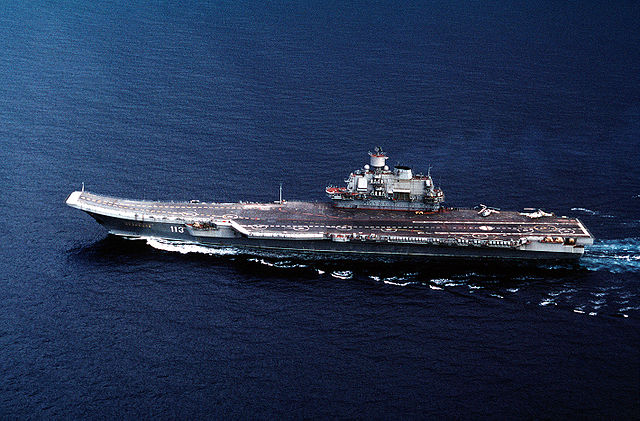
From November 2016 to January 6, 2017, Admiral Kuznetsov departed with her CBG to the coast of Syria. During this mission, she took part for the first time in real combat operations, making strikes on Jihadists. On November 14, 2016, a MiG-29K crashed while landing but the pilot survived and on December 5, 2016, a Su-33 crashed also in landing. She was back to Severomorsk on February 9, 2017 after 18,000 nautical miles. Strikes had been performed by Su-33 over two months, 420 combat sorties, 117 by night. Almost all took place in difficult weather. According to the authotities, they managed to destroy “1,252 terrorist targets” (Col. Gen. Andrei Kartapolov, Cdr in Syria). This operations cost the state 7.5 billion rubles. On February 23, 2018, she was awarded the Order of Ushakov by President Vladimir Putin.
Modernization (2017-2024)
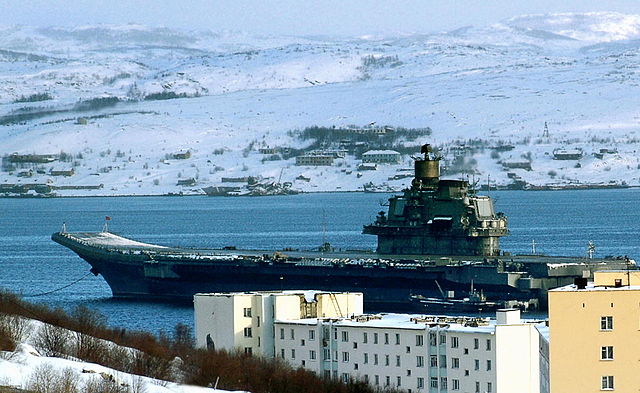
In 2017, Admiral Kuznetsov was back in Syria and by October the 82nd ship repair plant started to determine the necessary work to restore her full combat readiness. After the planned repairs and modernization, her service life would be extended by 10 years, to 2027. A contract for modernization worth 86 billion rubles was signed in April 2018 with the Zvezdochka ship repair center. Media reported that from June 23, 2021, her the avionics, flight deck, power equipment, and power plant had been completely replaced. She was to receive a new aircraft takeoff and landing control system developed domestically, but similar to the one developed for the Indian Vikramaditya. Deck aviation composition would remain the same, but the main Granit missiles were removed. Instead the smaller Pantsir-M SAM would be installed.
Modifications were done in Murmansk, at the PD-50 floating dock operated by the 82nd Ship Repair Plant. However on October 30, 2018, the floating dock sank and the carrier, still in the dock, suffered damage when the dock crane fell. She remained afloat and was towed to the 35th Ship Repair Plant berth. There were was no other dry dock capable of accepting her so it was decided to modernize existing dry docks of the 35th Ship Repair Plant and she was expected to be dry-docked again.
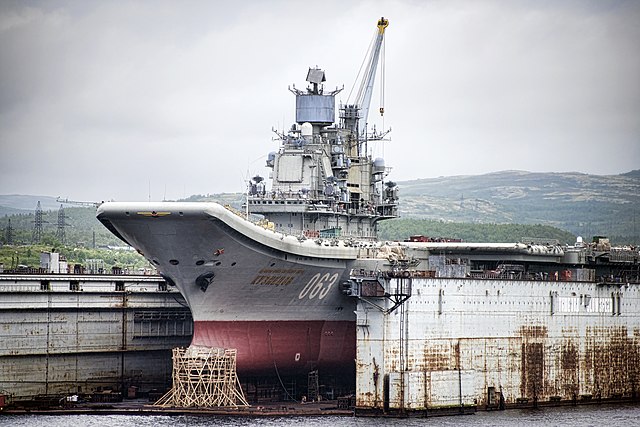
On December 12, 2019, a fire broke out on the ship during welding, when a spark fell into the hold where fuel was spilled. It took amost 24h to extinguish it. Two people died, ten injured. In April 2020, the United Shipbuilding Corporation as general contractor for Zvezdochka shipyard estimated the damage worth 500 million rubles. On December 22, 2022, a local fire, even greater, occurred during repair but the teams were better prepared and there was no casualties.
By early 2023, she started early trials, and at the end of 2023, was planned to re-enter service with the Northern Fleet until it was pushed back to the first quarter of 2024. On February 21, 2023 she left the dry dock of the 35th Ship Repair Plant, there from May 20, 2022. The plant director, Rakhmanov certified she was ready to be recommissioned in 2024.
In September 2024, an investigation reported that the 1,500-member of her crew had been sent on the frontline with Ukraine. Sailors from the aircraft carrier were formed into the mechanized battalion “Frigate”, 1st Tank Army. Since the, there are little hope to see the carrier in service again for the near future. It’s just no longer a priority.
About her Air group
The Kuznetsov was designed to support and service 28 aircraft and 24 helicopters excluding extra parking locations on special areas on the deck which pushed this to 36 aircraft total. The large number of helicopters is due to her focus on ASW operations. The current concept involves reducing the park of Su-33s and replacing them with lighter and more compact MiG-29K fighter-bombers for the same role. This brought the total to 36 total, included 23 MiG-29Ks. The number of based helicopters is then reduced to 17.
The Military Balance 2016 reference book showed a combo of MiG-29K and MiG-29KUB fighter-bombers, 23 total. According to Global Security and The National Interest, MiG-29K had a full seto of avionics, including an infrared target finder and guidance of short-range air-to-air missiles based on the pilot’s head turn as well as guiding KAB-500 bombs, R-77 air-to-air missiles, Kh-35 anti-ship missiles. The laternative are 18 heavier Su-33 carrier-based fighters. They have a combat load of bombs and missiles of 6.5 tons (3.2 tons a interceptors). In case of a formation of an assault strike group, the park could be shiftred for Kamove heliocopters used for assault and new Ka-52K helicopters to support amphibious operations, notably after the cancellation of the Mistrals.
About her her peculiar status
The advantage of her unusual design, combining a missile cruiser and an aircraft carrier, Admiral Kuznetsov is actually the only aircraft carrier which can operate both on the norrthern and Black Sea fleet. Indeed, clause B.2 of Appendix II of the Montreux Convention dis not consider the Admiral Kuznetsov as an “aircraft carrier” due to her carrying the Granit missiles but she is interpreted as a “battleship” so she could pass through the Bosphorus and Dardanelles. This was argued when she had to join the Northern Fleet back in 1991.
Another significant factor is found under Article 19 of the Montreux Convention. It states that even if the she is used to wage war against a coastal Black Sea state (here, Ukraine) Turkey has no right to prevent her from entering the Black Sea without declaring war on the Russian Federation. The exception for closing the straits would be the “assistance rendered to a state that has become the victim of an attack” but this required at a time a decision by the League of Nations, and the new UN no longer the text relevant due to technological advances. There is currently a legal fog that could allow Russian to send the carrier back to the black sea for operations against Ukraine on paper, but as shown by the loss of Slava, it’s unlikely to happen.
In her amphibious configuration, the aircraft carrier can carry about 30 heavy attack and transport helicopters, surpassing even large assault ships.The deck is trong enough to allow the operation of the large Mi-28 and Ka-50/52. In February 2016, the Russian government announced the creation of the 97th Airborne Assault Regiment in Crimea, based on the 7th Guards Airborne Assault Division from North Caucasus, entirely heliborne. However this id counterbalanced by the fact the ship have no deicated space for long-term accommodation of troops. This would be possible for a short deployment such as on the confines of the black sea, and mostly to support a landing force with attack helicopters.
 Varyag (2017)
Varyag (2017)

Varyag in Istambul, ready to be transferred to her new mysterious owner in Asia. As her sister, in addition to be incomplete, she was argued to be the same type of “heavy cruiser” to pass the Montreux convention.
Kusnetsov’s Twin, started at Nikolayev in 1985 just after the launch of his sister-ship, was named “Riga” and launched herself under this name in December 1988. But by the time of her completion, USSR imploded and Latvia’s departure motivated a name change for “Varyag” (a reference to the old Byzantine Varanguian Guard). However funds for her completion were lacking to complete her electronics and amement. She laid at was 70% complete with a complete completion at a cost of $500 million that was no possible for the current Russian government. So she was to be sold either for scrap or to a potential buyer. Ukraine in 1992 received her and intended to potentially resell her to the Indians and Chinese as both seemed interested. Lacking funds, Ukraine sold her in 1994 to be BU as no buyer and in 1997, her equipment already reached an age limi so it was imperative to sell her at a low price. It’s a Macau tour company that bought it in 1998, officially to turn her as a casino and floating hotel at just $ 20 million (this was almost scrap value).
Negociations however went for quite a time. In 2000 as she was ready to depart, the Turkish government refused to allow her crossing the Bosphorus Strait on ground of merchant traffic interruption and danger of stranding as well as a violation the Montreux Treaty, until an agreement was reached directly between the Chinese buyers and Turkish government. Varyag was anchored off the Bulgarian coast assisted by a Chinese tug and she eventually crossed the strait in October 2001 but headed for Dalian for conversion instead of Macau in 2004. She became Type 001 Liaoning, first PLAN aicraft carrier and today considered as a training carrier as the middle empire is launched in a frenzy of CATOBAR construction.
Evaluation
Western Perception
Originally designated in the West as ‘Black-Com-2’ class (“Black Sea Combatant 2”) she became the “Kreml” or ‘Kremlin’ class. Finally it was redesignated ‘Kuznetsov’ class after briefly being concurrently called the ‘Brezhnev’ class. Western analysts thoiugh she would have a Combined Nuclear And Steam (CONAS) propulsion plant like the to the Kirov class battlecruiser and SSV-33 support/command ship. It came as a surprise as she was conventionally propelled with oil-fired boilers. Western intel first report preparations for construction (on open air) back in late 1979. First public image was leaked through the “Morrison Photos” using overhead satellite imagery. Another leak over a decade later showed her sister ship being dismantled.
Despite its conventional powerplant, which still made sense for relatively short deployments in the Med and Atlantic, to accompany SSBNs, still provided the Soviet Navy with a potential inconvenvience for the armada of ASW tracks deployed by the USN. A lone P3 Orion for example would have been an easy prey for Mig-29K and Su-33s. The intervention of USN carrier group escorts was now a new strain on USN capabilities, mobilizing at least one CBG to cover 2-3 simultaneous Atlantic explorations by patrollers.
In the case of an ASW hunt relatively close to a Soviet carrier engagement area, there was the danger of interception by now quite capable fighter as well, so again, an escort became mandatory and a brand new system of rotating fighter patrols to face the new threat. Still, it was recoignised that the lack of catapults would reduce the missile load (especially long range models) of these aircraft, but the intersection bubbles were now larger than ever. The semi-CATOBAR (Ulyanovsk) would certainly have been a more serious threat altogether. Howwever, the habit of the Russian Navy after the loss of kursk to deploy the carrier in the confines of the Mediterranean completely changed the game as the sea is mostly NATO-controlled, notably by Greece and Turkey to the north. There were not that many ports open to Russian CBGs but Tartus in Syria and perhaps Libya, at least until 2015.
Now the ageing career is mostly considered inactive despite affirmation of the contrary and as of 2024, stuck in post-overhaul limbo.
Russian Perception
General political and tactical assessments was underlined by Experts from the Air Force, assessing her design, and on the long run, determined her most important significance was simply to maintain a previous experience in using aircraft carriers and having qualified carrier pilots. This a modernization to take place and guarantee experienced personnel whe needed again and when creating new Russian aircraft carriers. Western BBC experts also believed the strike operations in Syria, the first by a Russian carrier ever, also were a precious sum of experience that few countries had at the time (it’s still true). In the 2000s it was only shared by the US and France.
Israeli military observer Anshel Pfeffer noted that for NATO, only the United States had superiority over Russia in aircraft carriers with other countries having smaller/older aircraft carriers. The case of Charles de Gaulle, likely to meet her in the Med, was still significantly smaller, her nuclear power negeated in this sea, with a relatively limited air wing, albeit with the advantage of AWACS (the Hawkey). Aprt her only a rotating 6th fleet CBG was not systematic. Plus the French carrier was single and needed overhaul, leaving the Med practically free for the Russians. The UK prior to completed the two Queen Elisabeth (which had long completion time and delayed air groups) had no Invincible-class carriers to deploy.
Back to the French CDG its air group of 40 aircraft with experience was capable of much more intense rotations and activities, while Italy, which had smaller VTOL carriers entered the game recently with the impressive Trieste also like the British equipped with the F-35, which had no equivalent in the Russian naval air groups. Con Coughlin believes that Admiral Kuznetsov had a narrow opportunity when completed, but now the game is mostly over. She could not return to the black sea and trying to force her way through a strait controlled by the NATO country given the current context is very unlikely and potentially dangerous, despite the possible help given by the carrier to off shore support in some area. Given the loss of Slava, there is no certaintly of success here.
Criticism
According to Western experts, the cruiser has never performed its designated tasks, and is generally considered unreliable, with hull, power plant, arresting gear issues and a largely innefective modernization. In 2016, in an article of The Wall Street Journal about the carrier strikes in Syria, it was stated that she lacked highly qualified pilots, and those available did not have sufficient combat experience. Added to this was the complication of reduced payload and fuel due to the sky-jump. In 2018, The National Interest ranked Admiral Kuznetsov as the “top five worst aircraft carriers in history” pointing out her unrreliable powerplant and poor maintenance standards, the need of constant, major repairs and the presence of at least a tug for each of her short sorties. She ranked second in Business Insider’s “2018 worst aircraft carriers” citing again her general unreliability and many shortcomings. The sinking of her PD-50 floating dock and several fires also highlighted poor safety practices and lack of (or irrespect of) procedures. This casted doubts overall about the need for upgrades altogether. The same doubts were also expressed by the Russian Defense Ministry and military experts as well.
Incidents
Apart her overhaul issues, the ship’s air group had also some mishaps, which were awaited given this art form was brand new for the Navy. On October 18, 2004, a Su-25UTG crashed after a hard landing. Its right landing gear broke but instead of ploughing into parked aircraft, her landing hook caught on the arresting gear cable and limited her mad run on deck. Probable causes included pilot error and metal fatigue. It was later written off.
On September 5, 2005, two Su-33 fighters crash-landed while in the North Atlantic. One fell into the ocean and sank under 1,100 meters but Lieutenant Colonel Yuri Korneyev ejected and was picked up by the plane guard. The other remained on the deck. The prime cause was a broken arresting gear cable. Fearing recuperation by the west (perhaps following Project Azorian revelation by Reagan to Gorbatchev) the sunken aircraft was planed to be destroyed by depth charges but at this depht it proved impossible.
On January 6, 2009, while moored during exercises at the Turkish naval base of Akzas, a fire broke out a forward compartment and was extinguished, almost without casualty and relativly quickly. Still the fire. Carbon monoxide poisoning still claimed conscript sailor Dmitry Sychev. On a January 11 she was however capable of joint exercises with Greece. On November 14, 2016, a MiG-29K fighter jet crashed at sea while landing off Syria. The pilot ejected and was rescued.
On December 4, 2016, a Su-33 overrun the deck and plunged to the sea after the arresting cable snapped. The pilot managed to eject and was rescued.
On the night of October 29-30 the worst accident while in overhaul happened. There was sudden power outage from the shore and one of the floating dock PD-50 ballast control failed. She started to fill and list badly in Roslyakovo. This soon became uncontrolled. An investigation later showed that Rosneft, which previously purchased the 82nd Ship Repair Plant had reduced the dock’s engine crew and not purchased fuel for its diesel generators in order to cut corners. PD-50 thus was unable to switch to its own power supply to pump water out of the tanks, which were hold at bay as long as energy was provided. She sank along with the aircraft carrier Admiral Kuznetsov and the lost also caused a 70-ton tower crane to fell onto the carrier deck, making quite a lot of extra damage. In fact it created a hole in the deck at the stern, about 20 m² and the crane also damaged several compartments below. There was also one missing worker, later assumed dead.
The Transport Investigation Department opened a criminal case, under Article 216 of the Criminal Code for “Violation of safety rules during other work, which resulted in the death of a person through negligence”. A representative of the Ship Repair Center, Yevgeny Gladyshev, reported that the crane lying on the damaged deck would not be lifted under the ongoing investigation. On the night of November 18, 2018, one of the four injured workers in the accident died at the Murmansk City Hospital adding another to the list of fatalities. Bu this was not over.
On December 12, 2019, a fire broke out on an area of 600 m² when she was moored for fixes at the 35th Ship Repair Plant, Leninsky District, in Murmansk. Two people died, 12 were injured by smoke inhalation and bures. This was her most serious fire of her career, almpst comparable to 1950-60s Forrestal’s blazes. The fire, which took from spilled residual fuel oil due to cleaning negligence, took from 11 a.m. December 12, to 8 a.m. December 13 to master. Damage assessment was of several months and extended the overhaul until 2024. The yard’s director, already suspected for negligence and corruption, was arrested.
1988 Successor: ULYANOVSK class aircraft carrier
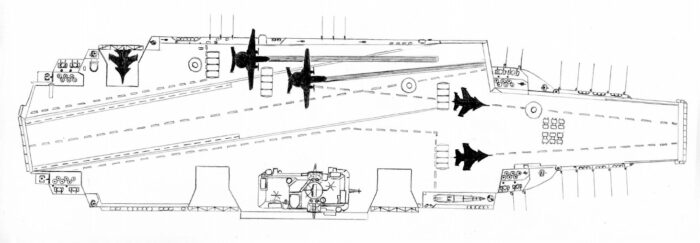
This was the projected nuclear-powered successor to the Kuznetzov class, equipped with conventional steam catapults. She was laid down at Nikolayev in December 1988 and although her launch was expected during 1991, the economic collapse that year badly slowed work, and the split between Russia and Ukraine made essential parts such as the reactors were undeliverable. By February 1992 this ship, which was 40 per cent complete, was being broken up.
Reportedly Russia and Ukraine were unable to agree on her ownership, so they decided to share the proceeds of the scrap sale. She had been laid down on the slip vacated by Varyag (ex-Riga). A second unit was probably planned, but she was never laid down because Ulyanovsk was not launched. Prior to her cancellation, it was reported that she would be renamed Petr Veliky (“Peter the Great”) if completed. Few details are available, but reported length was about 320m (1050 ft).
It seems likely that the planned powerplant was a pair of Kirov plants (nuclear/steam turbine). Effective maximum power would depend on how much could usefully be transmitted through the propellers.
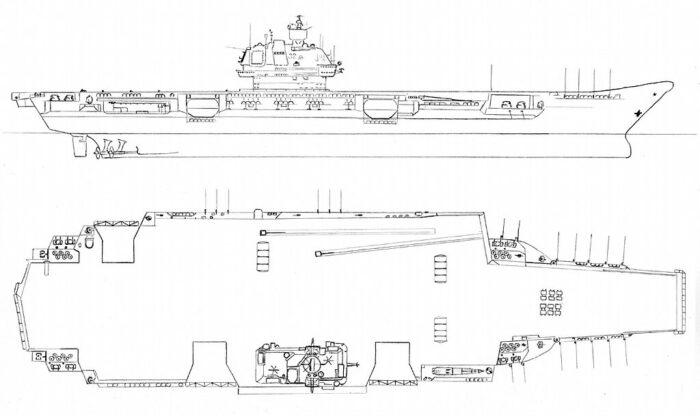
The air group was to comprise 68 aicraft in all, fitting in her massive hangar of 175 × 32 × 7.9 meters and comprising 44 fighter aircraft, between Sukhoi Su-33 (Su-27K) and Mikoyan MiG-29K fighters but also six Yakovlev Yak-44 RLD airborne early warning aircraft and 16 Kamov Ka-27 anti-submarine warfare helicopters as well as two Ka-27PS air-sea rescue helicopters. There were intended to carry two “Mayak” steam catapults forward of the angled deck, made by the Proletarian Factory in Leningrad, combined still with a ski-jump forward and four arresting gear aft.
The catapults were intended for the AWACS but could have been useful so propel fully laden fight bombers in support missions. The ski-jump was for fighters. She was to have also three elevators with a carrying capacities now of 50 tons, two starboard, one port). She was als given a much smaller island and the latest “Luna” optical landing guidance system.
Armament was still impressive with twelve P-700 Granit SSMs, four 3S90 Uragan SAMs, eight CADS-N-1 CIWS, and eight AK-630 rotary anti-aircraft cannons.
For all this, the great novelty was her use of nuclear power, with four KN-3 nuclear reactors and four steam turbines for a total of 280,000 shp (210,000 kW) versus 200,000 on the Kuznetsov.
Current aircraft carrier projects
The Project 1143 lineage (and 1160/1153)
In the past, there were already many carrier projects, here is the list:
Project 1160: preliminary design of an aircraft carrier with 80,000 tons displacement, rejected as too costly.
Project 1153: Heavy aircraft cruiser. 50 aircraft, 60,000-70,000 tons. No selected.
Recommended design (unclassified) 80,000 tons, 70 aircraft, not retained for development.
Project 1143M: Hybrid Carrier for the Yak-41 VTOL. Classed as 1143.3, laid down in 1975, adopted in 1982, las Kiev class (improved).
Project 1143A: Improved Kievs (Project 1143M), larger displacement. Laid down in 1978, adopted 1982 converted as Indian Vikramaditya 2004-2012.
Project 1143.5: Heavy aircraft carrying cruiser, 5th variant, Kuznetsov.
Project 1143.6: Improved Heavy aircraft carrying cruiser, Varyag. Later purchased by China, transformed as Type 001.
Project 1143.7: Proposed Ulyanovsk, CATOBAR, nuclear-powered carrier (see specs above).
The reboot: Project 23,000
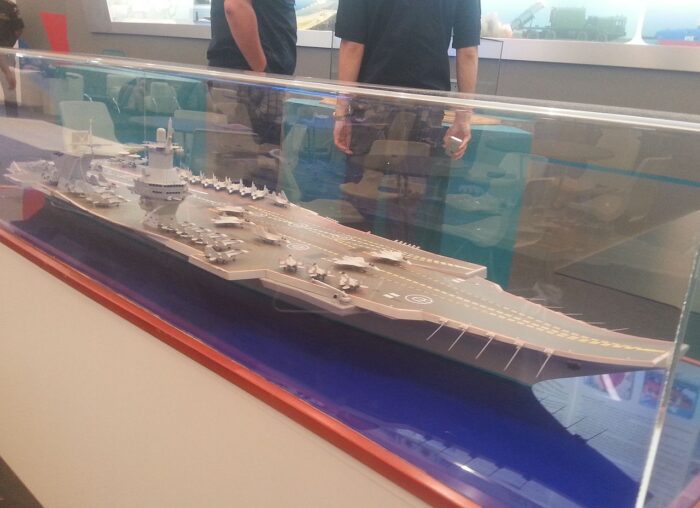
Project 23000 also named “Shtorm” (‘Storm’) was a proposal aircraft carrier by the Krylov State Research Center, for the Russian Navy. It was revealed as a model at Armiya 2015 alongside a flurry of other new weapons system. It was also intended for export to cover part of the global expenditures, at a unit cost of over US$5.5 billion. In 2017 if approved, development had been expected to take ten years, so until 2027. As of 2020, it still had not been approved. From 2022 and the invasion of Ukraine it’s unlikely it would return as a priority.
It was back in 2017 considered for service with the Northern Fleet as another “heavy aircraft cruiser” to replace the aging Kuznetsov aroind 2027-2030. The Nevskoye Design Bureau took also part in its development project which retook many elements from studied made for the Project 1143.7 Ulyanovsk. The 2015 exhibition also exposed a massive new escort, the Lider-class destroyers, a nuclear powered missile destroyer that was closer in size to the previous Kirov class. The whole project was postponed by Russian President Vladimir Putin albeit both were still registered for disvussion in the Programme for 2018–2027, released back in May 2017. Some Russian officials affirmed a new carrier would be laid down between 2025 and 2030 and that if built, it was to have the new S-500 surface-to-air missiles in development. It was also in July 2016 proposed to India before the latter preferred its own design, the Vikrant.

Shtorm-KM from Krylov center, DW 76kt Primary Nuclear powerplant and gas turbine secondary.
Read More/Src
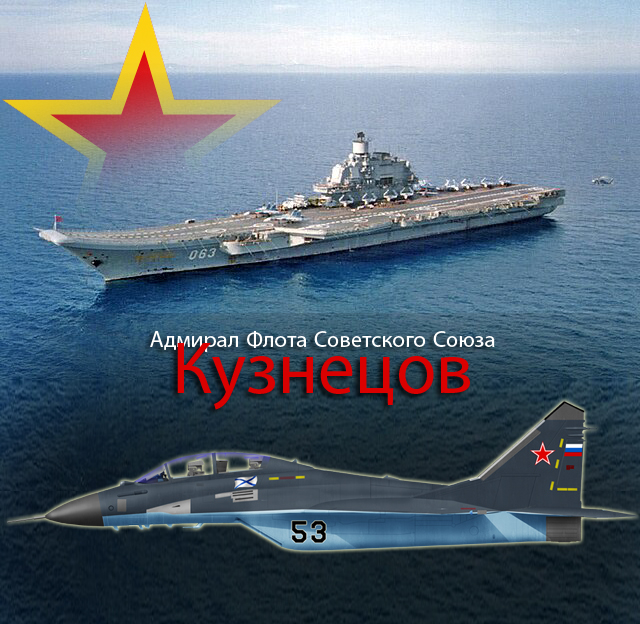
Books
Links
a brief look at soviet carrier development
on globalsecurity.org/
web.archive.org navypedia.org/
Project 1143.7 shtorm
on businessinsider.com/
web.archive.org/ nwc.navy.mil
globalsecurity.org 1143_7
web.archive.org/ nwc.navy.mil art7su98.htm
hazegray.org/ russia.htm#ulya
Project 23000
on ru.wikipedia.org/
www.janes.com/
okbm.nnov.ru/
defensenews.com/
tass.com/russia/797980
defensenews.com/ russia offers india nuclear aircraft carrier/
armyrecognition.com/ russian shtorm aircraft carrier
web.archive.org/ janes.com/ russia-offers-indian-navy…
interfax.ru

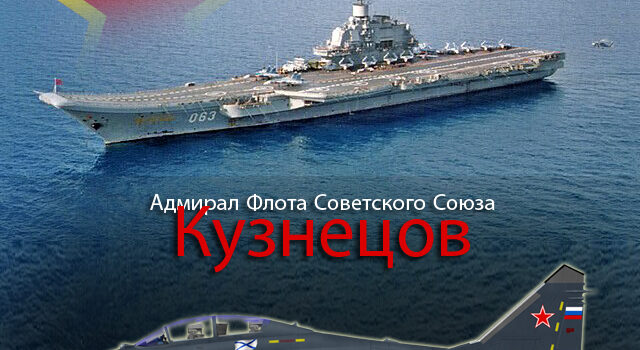
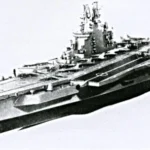
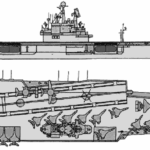
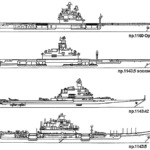
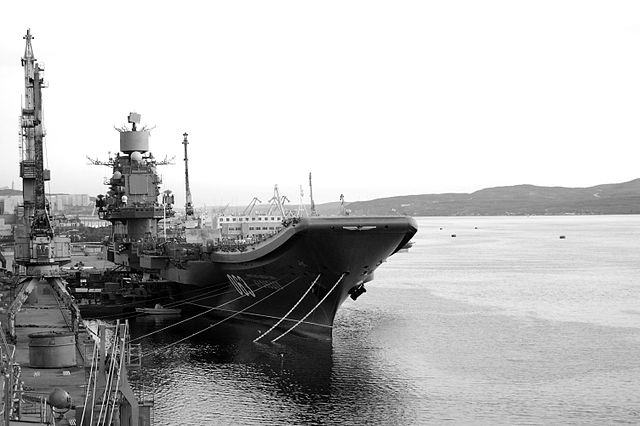
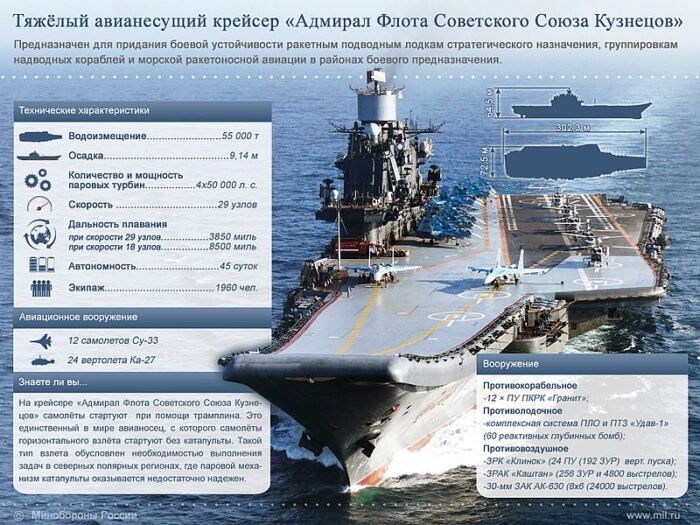

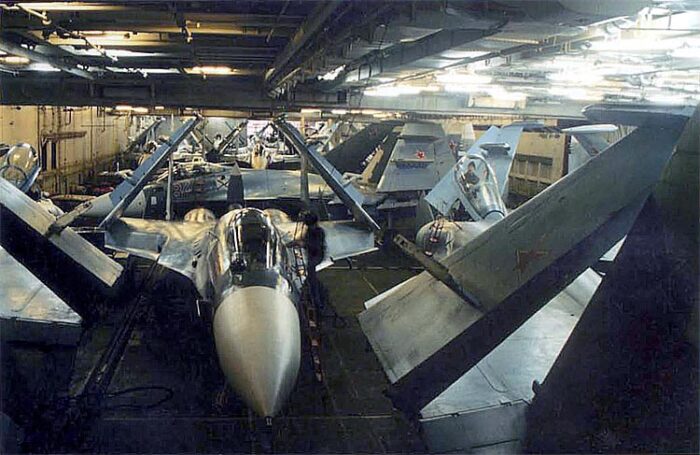
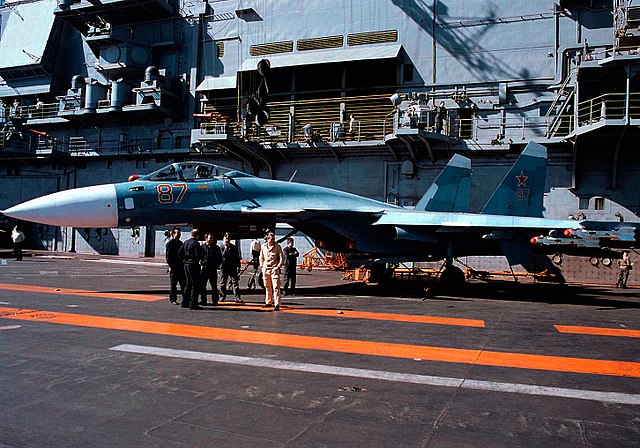
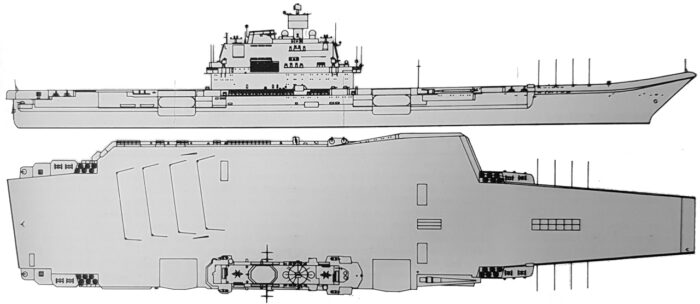
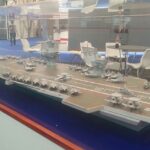
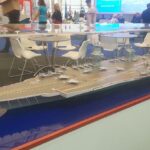
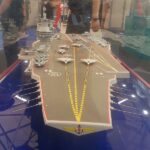
 Latest Facebook Entry -
Latest Facebook Entry -  X(Tweeter) Naval Encyclopedia's deck archive
X(Tweeter) Naval Encyclopedia's deck archive Instagram (@navalencyc)
Instagram (@navalencyc)





 French Navy
French Navy Royal Navy
Royal Navy Russian Navy
Russian Navy Armada Espanola
Armada Espanola Austrian Navy
Austrian Navy K.u.K. Kriegsmarine
K.u.K. Kriegsmarine Dansk Marine
Dansk Marine Nautiko Hellenon
Nautiko Hellenon Koninklije Marine 1870
Koninklije Marine 1870 Marinha do Brasil
Marinha do Brasil Osmanlı Donanması
Osmanlı Donanması Marina Do Peru
Marina Do Peru Marinha do Portugal
Marinha do Portugal Regia Marina 1870
Regia Marina 1870 Nihhon Kaigun 1870
Nihhon Kaigun 1870 Preußische Marine 1870
Preußische Marine 1870 Russkiy Flot 1870
Russkiy Flot 1870 Svenska marinen
Svenska marinen Søværnet
Søværnet Union Navy
Union Navy Confederate Navy
Confederate Navy Armada de Argentina
Armada de Argentina Imperial Chinese Navy
Imperial Chinese Navy Marinha do Portugal
Marinha do Portugal Mexico
Mexico Kaiserliche Marine
Kaiserliche Marine 1898 US Navy
1898 US Navy Sovietskiy Flot
Sovietskiy Flot Royal Canadian Navy
Royal Canadian Navy Royal Australian Navy
Royal Australian Navy RNZN Fleet
RNZN Fleet Chinese Navy 1937
Chinese Navy 1937 Kriegsmarine
Kriegsmarine Chilean Navy
Chilean Navy Danish Navy
Danish Navy Finnish Navy
Finnish Navy Hellenic Navy
Hellenic Navy Polish Navy
Polish Navy Romanian Navy
Romanian Navy Turkish Navy
Turkish Navy Royal Yugoslav Navy
Royal Yugoslav Navy Royal Thai Navy
Royal Thai Navy Minor Navies
Minor Navies Albania
Albania Austria
Austria Belgium
Belgium Columbia
Columbia Costa Rica
Costa Rica Cuba
Cuba Czechoslovakia
Czechoslovakia Dominican Republic
Dominican Republic Haiti
Haiti Hungary
Hungary Honduras
Honduras Estonia
Estonia Iceland
Iceland Eire
Eire Equador
Equador Iran
Iran Iraq
Iraq Latvia
Latvia Liberia
Liberia Lithuania
Lithuania Mandchukuo
Mandchukuo Morocco
Morocco Nicaragua
Nicaragua Persia
Persia San Salvador
San Salvador Sarawak
Sarawak Uruguay
Uruguay Venezuela
Venezuela Zanzibar
Zanzibar Warsaw Pact Navies
Warsaw Pact Navies Bulgaria
Bulgaria Hungary
Hungary

 Bundesmarine
Bundesmarine Dutch Navy
Dutch Navy Hellenic Navy
Hellenic Navy Marina Militare
Marina Militare Yugoslav Navy
Yugoslav Navy Chinese Navy
Chinese Navy Indian Navy
Indian Navy Indonesian Navy
Indonesian Navy JMSDF
JMSDF North Korean Navy
North Korean Navy Pakistani Navy
Pakistani Navy Philippines Navy
Philippines Navy ROKN
ROKN Rep. of Singapore Navy
Rep. of Singapore Navy Taiwanese Navy
Taiwanese Navy IDF Navy
IDF Navy Saudi Navy
Saudi Navy Royal New Zealand Navy
Royal New Zealand Navy Egyptian Navy
Egyptian Navy South African Navy
South African Navy






























 Ukrainian Navy
Ukrainian Navy dbodesign
dbodesign